According to New Atlas, Hyper’s HyperSpace Trackpad Pro reached its Kickstarter funding goal within minutes last month, targeting Windows users who’ve wanted Apple-style trackpad experiences. The device measures 166.9 x 103.4 x 13.0 mm, weighs 300 grams, and features soda-lime glass with rubber feet for stability. Early backers can get it for $90 versus the planned $150 retail price, with production starting in December 2025 and first shipments scheduled for March 2026. The trackpad offers force sensing, contextual haptics, and works with Windows 10 and 11 via Bluetooth out of the box. Battery life lasts three to four weeks with typical usage, charging via USB-C while remaining operational during charging.
<h2 id="windows-finally-catches-up”>Windows finally catches up
Here’s the thing: Windows users have been living in trackpad poverty compared to Mac users for years. Apple’s Magic Trackpad has been this beautifully integrated experience that Windows laptop makers never quite matched, and desktop users? Forget about it. Now Hyper is stepping in with what looks like the first serious attempt to bridge that gap.
What makes this interesting isn’t just the hardware specs—it’s the software integration. The Hydra Connect app lets you create custom gesture profiles for different applications, which is basically the secret sauce that makes Apple’s trackpads so productive. Being able to switch brushes in Photoshop or skip PowerPoint slides with gestures? That’s the kind of workflow efficiency Windows has been missing.
The real game changer
Force sensing and contextual haptics could be massive for creative work. Most Windows trackpads still feel like they’re stuck in 2010—binary tap-or-not-tap experiences. The promise of different pressure levels and smart palm rejection means this might actually work for detailed editing in Adobe apps rather than just being a mouse alternative.
But here’s my question: will Windows itself play nice with this? Apple’s trackpad magic works because macOS is built around those gestures from the ground up. Hyper is essentially building both the hardware AND the software layer to make this work on Windows. That’s ambitious, and if they pull it off, it could pressure Microsoft to finally take trackpads more seriously.
The Kickstarter caution
Look, we’ve all seen promising hardware Kickstarters that either deliver late or not at all. March 2026 is a long way off—that’s nearly two years from now. A lot can happen between funding and shipping, especially with complex haptic technology and custom software development.
The price is attractive at $90 for early backers, but $150 retail puts it squarely in premium peripheral territory. For that money, people will expect flawless performance, not just basic pointing and clicking. The fact that it works in basic mode on Mac but needs Windows for advanced features is smart—they’re not locking out potential customers, but they’re clearly focused on solving the Windows trackpad problem specifically.
If Hyper can actually deliver what they’re promising, this could finally give Windows users the sophisticated input device they’ve been missing. But the proof will be in the shipping—and whether the software integration holds up in daily use. You can check out their Kickstarter campaign if you’re willing to take the early adopter plunge.




